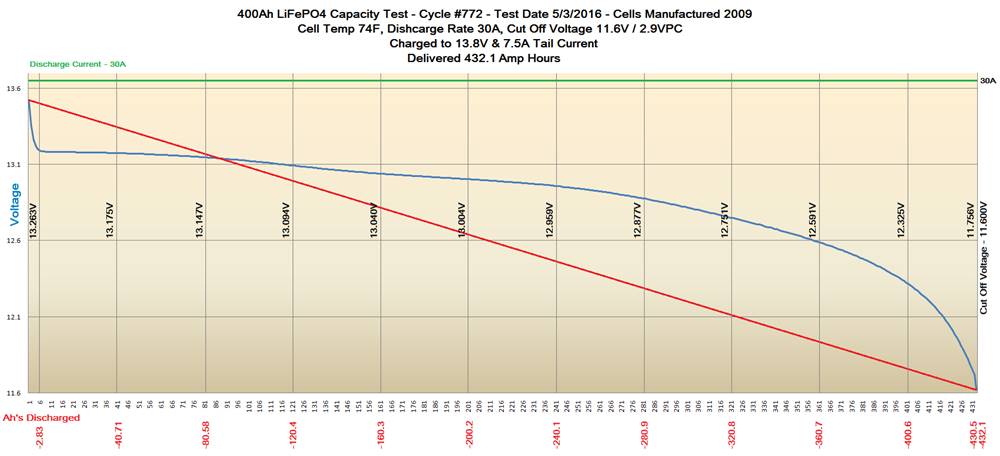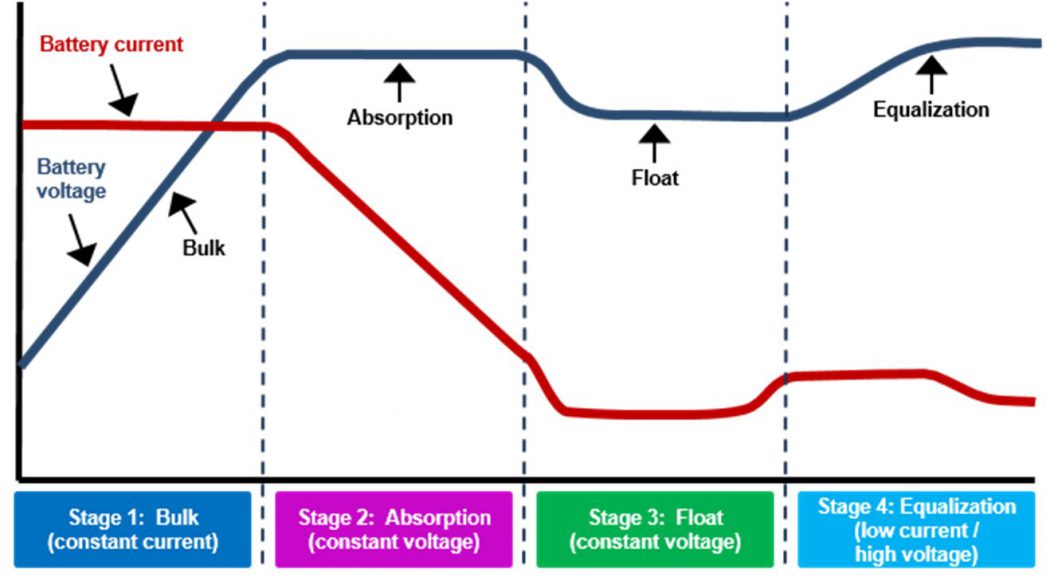A ridiculous amount of time has been spent studying the electrical system on my boat. The lithium batteries brought a whole other level of research to ensure I didn’t create a safety hazard. I make no promises to the accuracy of this information but I am reasonable certain it is accurate.
Seven days in, I typically don’t see the voltage drop below 13.2V on the house batteries, in the morning it is taking less than an hour for the solar controller to drop to Float at a house voltage of 13.4V. Lithium battery voltages don’t vary much. I’m not sure how the BEP Marine 600 determines the available remaining battery capacity, I assumed it was mostly based on the current passing by the shunt. I’m tracking my daily “low” value and I’m typically seeing the BEP 600 showing 60Ah – 100Ah usage from the previous night (during the day the solar keeps the batteries topped). I am highly suspect of the “used” Ah reported by the BEP, since in the morning I could only possibly add 10 amps or so before the voltage increases and the solar control switches to Float. This leads me to believe that my usage is much, much less. More data to collect to get a better idea of power usage and the limits of the system.
Technical Data on my setup:
Thunder Sky/Winston LYP cells:
Cell Voltage (3.2V per cell) = 12.8V
Lower Limit (Never Exceed Value) = 10.8V
Upper Limit (Never Exceed Value) = 16.0V
CleanPowerAuto HousePowerBMS:
Low Voltage Cutoff, turn on = 11.6V for 10 seconds
Low Voltage Cutoff, reset = 12.4V
High Voltage Cutoff, turn on = 14.4V for 10 seconds
High Voltage Cutoff, reset = 13.8V
InterVolt PSR12150 Programmable Voltage Relay:
Low Voltage Cutoff = 12.0V after 8 seconds
Alarm Voltage = 12.2V after 10 seconds
Upper Voltage Reset = 12.3V after 5 seconds
InterVolt devices were removed and replaced with a Contactor (controlled by the BMS system)
What I learned is that all chargers have three or four stages:
Bulk (battery needs a lot of recharging) = 100% of available power to batteries
Absorption (normal daily recharging) = Up to 100% of available power, amps decrease as battery voltage increases
Float (fully charged battery) = Small trickle charging
Storage (battery not used) = Small trickle charging, lower voltage than Float)
Victron 150/60 Solar Controller, programmed for LiFePo4 (switch set to 7):
Absorption (normal daily recharging) = 14.2V
Float (fully charged battery) = 13.5V
Storage = N/A
Victron 150/60 Solar Controller, absorption time varies by the battery voltage in the morning:
Less than 11.9V =6 hours
11.91V to 12.2V = 4 hours
12.21V to 12.6V = 2 hours
12.61 and higher = 1 hour
Victron MultiPlus 12/3000/120 Inverter
Absorption (normal daily recharging) = 14.2V
Float (fully charged battery) = 13.5V
Storage (fully charged battery) = 13.2V
Victron MultiPlus 12/3000/120 Inverter, Program Settings
DC input low voltage shutdown = 11.00
DC input low start = 12.60V
Repeated absorption time = 1 hour
Repeated absorption interval = 7 days
Maximum absorption time = 8 hours
Charge current = 115A
Inverter voltage = 120V
Internal transfer AC low disconnect = 94V
Internal transfer AC low connect = 101V
Internal transfer AC low disconnect = 138V
Internal transfer AC low connect = 143V
System frequency = 60hz
AC input current limit = 30 amps
Virtual Switch = Off
Number of slaves = 0
Virtual Switch = Off
BEP Marine 600 Settings:
400AH
Charge Efficiency 99%
High Volts Alarm 14.20V (0.2V before BMS disengages for high battery)
Low Amp Hours 100AH
Low Volts Alarm 12.00V (0.4V before BMS disengages for low battery)
Peukert’s Exponent 1.08
Reset capacity 5 amps
Voltage Discharge Curve for 400aH Winston LiFePO4 cells

Rod “RC” Collins captured the data and created the chart above. His website has extensive information about LiFePO4 batteries on boat.
Here is the extrapolated data from Rod’s chart:
13.50V = 0 Ah
13.18V = 50 Ah
13.13V = 100 Ah
13.05V = 150 Ah
13.00V = 200 Ah
12.94V = 250 Ah
12.82V = 300 Ah
12.63V = 350 Ah

Hi, thanks for your blog, very useful. It looks like the BMS you used is no longer available. Do you have a second choice that might be available now? Also do you feel a external be a mess is necessary for the off-the-shelf batteries that have internal BMS?
That is disappointing to hear about CleanPower Auto, but I’m not shocked since they had partnered with a battery company to incorporate their design into a total solution. When I was researching options they were the only DIY design that I located. Maybe something new is out there but I’m not sure. I have a couple of friends who do not have a BMS system on their small (400ah and 600ah installs) battery banks. These have been installed 3+ years and so far they have not had any problems (but do require occasional testing to ensure the cells are balanced). Personally I want the security of BMS so if I was starting over today, I’d look at the batteries with BMS built-in (which make it very simple). The downside, when I was looking, was the cost. Good luck.
Thanks for your reply. The batteries I’m considering do have internal BMS, but they are pretty primitive, non-programmable, and seem to protect against catastrophic failure, but not “best practices”.
So I’m intrigued by the battery charge chart above . This is for LiPo4 isn’t it Not LiFePo4 which has a much lower nominal voltage.
I’m not sure which chart you are referring to in your comment. The chart at the top does not list voltages and the tables in the post are correct and accurate for LiFePo4. But if I have a mistake I really would like to correct it so please let me know where you see an error. Thanks!